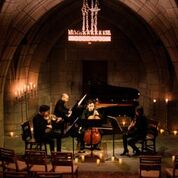Olivier Messiaen’s Quartet for the End of Time made a high-prestige appearance Feb. 5 as the one and only work in concert series known as The Crypt Sessions – a sought-afte insider ticket for a few years now, presented at the Church of the Ascension Crypt in Harlem by the non-profit organization Death of Classical.
Always a thoughtfully-curated series, this concert had the kind of repertoire, performing space and penetrating performance that yielded fresh questions about the nature of, well, everything. The lineup of strong personalities but dedicated chamber musicians for this one-night-only performance was violinist Stefan Jackiw, cellist Jay Campbell, clarinetist Yoonah Kim and pianist Orion Weiss.

The 1941 Messiaen work departs thoroughly but not radically from the typical chamber music works of the past (eight movements, descriptive subtitles) and has also long transcended the mystique that comes with having been written and performed in a World War II prisoner-of-war camp. In the most recent recording that I heard on the boutique label Genuin featuring pianist Cedric Pescia, the piece seemed to have moved into some super-tidy Scandinavian-style five-star hotel. But in the crypt, the prison camp origins felt closer. You had to re-contextualize the piece in these subterranean circumstances.
The piece often invites re-evaluation since you’re never sure what this invitingly hypnotic music is/was/could be. Starting with the title: To me, it has always suggested the end of the world (something that I’ve always look forward to). But the music only occasionally feels dire, apocalyptic or elegiac. Especially when heard in light of the composer’s later works (he lived until 1992), it has many typical features, including bird song, long meditative solos and rainforest-like jumbles of musical thoughts. Or so it seems in a modern concert hall.
Though a clean, open, nice-smelling space, the Church of the Ascension crypt returns Messiaen’s quartet to what feels like alien territory, not that in which it was premiered, but still alien. The opening notes suggested this music isn’t the end of anything but a new kind of inner life in which time is dissolved – a comfort, no doubt, for prisoners waiting to be liberated by allies or, for that matter, waiting for anything amid a series of endlessly meaningless days. Heard in this way, Quartet for the End of Time began to feel like an act of “inner immigration.”
That term was tossed around in World War II referring to individuals who waited too long to leave Nazi territories – or didn’t forsee what they would become – and simply had to retreat within themselves. Obviously, these POWs had much more vital reasons to turn inward but at the same time had the impetus to bond together with fellow prisoners for moral support.
Amid this, the composer was developing and codifying a sustainable inner life full of religious imagery (some comforting, some vengeful), nature at its most free (birds) and perhaps looking deep into the cosmos for the harmony of spheres. Then 32, Messiaen was poised and ready to write such a personal work.
His own program notes tend to expand the poetic possibilities more than explaining them. “Liturgy of the Crystal” has bird song plus “a halo of trills lost very high in the trees.” “Vocalise, for the Angel who Announces the End of Time” has what the composer describes as “almost plainchant song” but there is also here, and periodically throughout the piece, high-tension competition among the individual instruments.
The third-movement clarinet solo “Abyss of the birds” that seems to make itself up as it goes along is where the crypt performance became epic in its manner: The live but clear acoustic allowed clarinetist Kim to explore a huge range of color and volume while illuminating the music craggy events in all of their detail. And though the movement has some playfully birdy moments, the performance hit a point where you couldn’t possibly read it as existing in some Zen-like state that’s beyond earthy emotions. In the following movements, pianist Weiss fueled the music from within with emphatically flinty treatment of the piano writing.
Lamentation is part of the package, but in this performance, it felt more existential than personal, something confronting the problem of the human race with its need to have wars and take prisoners. The cello solo in “Praise to the Eternity of Jesus” continued with an air of rumination in what was the most emotionally concentrated account of the solo cello that I’ve ever heard. One initially felt the comfort of a religious presence but the pain of separation from longed-for divinity.
The program notes discuss “granite sound…huge blocks of purple rage, icy drunkenness” in the “Dance of Fury: movement, which can seem nearly as polite as a chess game in some performances, but not here, where it felt more like a frenetic dervish than a dance.
Finally, Jackiw, a violinist whose intelligence and genteel tone recalls the great Arthur Grumiaux, had his moment in the final “Praise to the Immortality of Jesus” movement, whose simple piano accompaniment allows the solo violin to embody a distilled version of Messiaen’s world where emotion teeters between glimpsing the infinite and falling back into mundane humanity. One is simultaneously grateful to be alive but left wondering how much conventional time must pass until you’re doing more than glimpsing the infinite.
I don’t know if Jackiw meant his high, soft final note to have a kind of raspy tentativeness, but it certainly worked for me. But in a conventional concert hall? It might’ve been perceived as a mistake. Maybe the combination of the music and the crypt left no room for mistakes. Things were the way they were meant to be.

